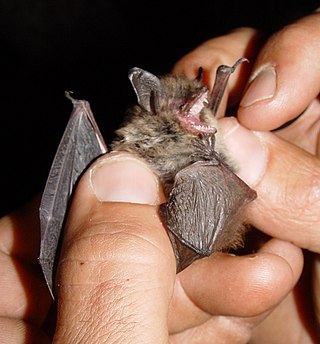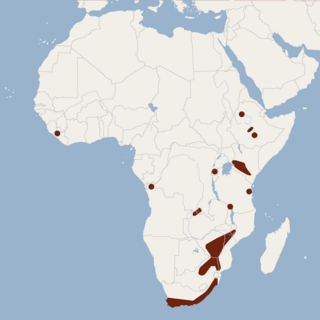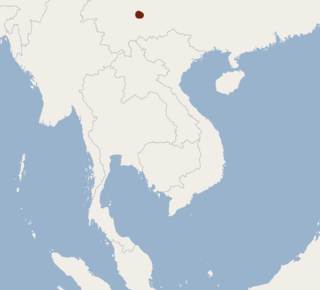
The mouse-eared bats or myotises are a diverse and widespread genus (Myotis) of bats within the family Vespertilionidae. The noun "myotis" itself is a Neo-Latin construction, from the Greek "muós and "oûs", literally translating to "mouse-eared".

The fraternal myotis is a species of vesper bat native to East Asia.

Hodgson's bat, also called the copper-winged bat or black-and-orange myotis, is a species of vesper bat in the genus Myotis, the mouse-eared bats. Favouring mountain forests, it is found throughout Central, Southeast, and East Asia, from Afghanistan to Taiwan. It is about 5 centimetres (2.0 in) long and is distinguished from most other species of bat in this range by its yellowish colouration.

The bronze sprite, also known as the black-gilded pipistrelle, is a species of vesper bat found in China, India, Myanmar, and Nepal.

Joffre's bat, also known as Joffre's pipistrelle, is a species of vesper bat in the family Vespertilionidae. It is the only member of the genus Mirostrellus. It is found in South and Southeast Asia.

The big-eared pipistrelle is a species of vesper bat in the family Vespertilionidae. It can be found in Indonesia and Malaysia. It forages over mud flats over Peninsula Malaysia but its roosting activities are unknown. Its habitat is being threatened by deforestation for agriculture, plantations, logging and fires but how it affects this bat or if it is adaptable are unknown.

The Australian myotis is a species of vesper bat. It is found only in Australia. This taxa may not represent a valid species. Only one specimen has ever been documented, supposedly from New South Wales. This specimen may have been mislabelled or a vagrant Myotis muricola or Myotis ater.

The fringed long-footed myotis is a species of vesper bat in the family Vespertilionidae. It is found in China, Taiwan and Hong Kong.

Findley's myotis is a species of vesper bat. It is found only on the Tres Marías Islands off the west coast of Mexico.

The Cape hairy bat, also known as little brown bat, Temminck's mouse-eared bat, Cape myotis, tricoloured mouse-eared bat, Cape hairy myotis, Temminck's hairy bat and three-coloured bat is a species of vesper bat that is found in Sub-Saharan Africa.

The black-bearded tomb bat is a species of sac-winged bat found in South and South East Asia.

Myotinae is a subfamily of vesper bats. It contains three genera: Eudiscopus, Myotis, and Submyotodon. Before the description of Submyotodon and analysis of its phylogenetics, as well as a phylogenetic analysis of Eudiscopus, the only member of Myotinae was Myotis.
Temminck's mysterious bat is a species of bat of the family Vespertilionidae.

The long-toothed pipistrelle is a species of bat of the genus Hypsugo. It is a small bat, with a length of 35.2–38.4 mm of forearm, and 5.9–7 mm of foot. It feeds on insects and has especially long canines compared to others of its genus.
The Taiwan broad-muzzled bat or Taiwan broad-muzzled myotis is a species of vesper bat found in Taiwan.

The chestnut myotis is a species of mouse-eared bat in the family Vespertilionidae. It is found in South Asia.

Myotis indochinensis, commonly known as the Indochinese mouse-eared bat, is a species of cave-dwelling bat in the family Vespertilionidae. It is found in Vietnam and China.

The long-toed myotis or Taiwan long-toed myotis is a species of vesper bat endemic to Taiwan.
Weber's myotis is a species of vesper bat endemic to the Indonesian island of Sulawesi.

















